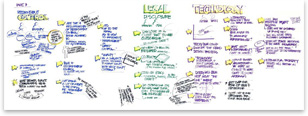
|
AIA Board Considers Offshoring Report Twenty percent of firms predicted to use international services by 2008 Summary: Offshore outsourcing of design-support services, such as computer-aided drafting, is a new business model for U.S. architects, the International Committee reported to the AIA Board at its December meeting. Board International Director Michael Lischer, AIA, RIBA, delivered the report on the September 25 Offshore Outsourcing Roundtable conference held in Washington, D.C. “We can now evaluate this business model without the unfocused fears of diminishing markets or the false promises of easy rewards,” wrote International Committee Chair Harold L. Adams, FAIA, in the report Lischer delivered. “We hope that the discussions reported in this paper and the recommendations for further action will help the AIA to lead the way forward and to fulfill its mission to facilitate and enhance the practices of its members.”
“For years economic globalization and bottom-line pressures have caused companies in many industry sectors to focus more on core competencies and to outsource non-core functions. Offshore service providers—notably in India and increasingly in China, South America, Eastern Europe, and elsewhere—attract much of the outsourced business through lower wages and economies of scale while helping firms to better manage fluctuating workloads and reduce production times,” writes AIA editor Mary Anderson in the roundtable report. “Architecture firms have moved perhaps more tentatively than other fields toward offshore outsourcing. Until recently, in fact, many architects have been reluctant to discuss the practice. The trend, however, is undeniable: Architects are outsourcing an increasing share of work traditionally performed in their own offices—primarily the drafting and documentation tasks most often assigned to junior employees—and they are outsourcing more of it to offshore service companies. Both driving and enabling this trend are technological advances in communications, electronic data transmission, and building information modeling (BIM).”
Consensus and next steps
The International Committee is committed to continuing its study of this issue and developing guidelines for addressing the concerns raised.
|
||
Copyright 2006 The American Institute of Architects. All rights reserved. Home Page |
||
news headlines
practice
business
design
Recent related
› To read the full Offshore Outsourcing Roundtable Report, visit the AIA International Committee site on AIA.org.


 Among the issues discussed were data gathering, standards, leadership
and collaboration, quality assurance, and security and liability.
Among the issues discussed were data gathering, standards, leadership
and collaboration, quality assurance, and security and liability.